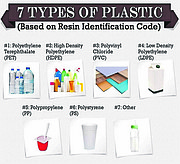By JULIA TOMLINSON
Our toxic love of plastic might be sending us to an early grave. Prostate and breast cancer rates have risen exponentially over the past couple of decades, fertility rates in men and women have dropped dramatically, young girls have entered early puberty, young boys have become increasingly hyperactive, and children have become obese.
All of these conditions result from multiple factors, but the effects of plastic cannot be ignored. We are surrounded by plastic; it is in our houses, walls, plumbing pipes, rugs, dental fillings, cosmetics, appliances, cars, garden mulch, and even in our food.
We’ve all heard advice about not microwaving our food in plastic. But what about other plastic products that come in direct contact with our food like takeaway containers, Tupperware, milk cartons, cling wrap, water bottles and many others? Does it mean that all plastics are toxic, and if so, do they leach toxins in our food?
In recent years there have been numerous studies and research papers on plastic toxicity and its effects on peoples’ health and the environment. And some show real cause for concern. However, general toxicity is not the only problem associated with the use of plastic. Something more sinister has appeared to be an even bigger health issue than previously thought – endocrine disruptors.
Endocrine disruptors are synthetic chemicals found in almost all plastic products that can mimic hormones and interfere or even disrupt the delicate work of our endocrine system.
You might remember from the biology class that our endocrine system plays an incredibly important role in all phases of development, metabolism and behaviour.
Our endocrine system is particularly vulnerable to these endocrine disruptors during the phases of accelerated development – in utero and early childhood development.
“We have very tight windows of when, say, our brain and liver are made,” explains Kristi Pullen Fedinick, a staff scientist at the Natural Resources Defence Council (NRDC) in New York.
“When a hormone-disrupting chemical gets in the way during these windows, it can change the ways these processes happen. The change is often irreversible.”
One example of endocrine disruptors is the main chemical used to produce plastics, Bisphenol A, or BPA. The substance is widely used in the plastic coatings inside aluminium food and beverage cans and it is also present in plastic straws, many plastic toys and the coatings of paper till receipts.
Heat, repeated washing, acidity, and alkalinity all cause the BPA in plastics to leach into our food and beverages. Last week, the European Chemicals Agency (ECHA) finally classified Bisphenol A (BPA) as an endocrine disruptor due to its “probable serious effects to human health, which give rise to an equivalent level of concern to carcinogenic, mutagenic, toxic to reproduction substances”.
BPA can also contaminate our groundwater by leaching from all the plastic sitting in landfills. And of course we ingest BPA from all the fish we eat that has previously ingested all that plastic floating around in the ocean.
In one study, the Centres for Disease Control found 95 percent of urine samples contained some amount of BPA. It’s in our blood, our amniotic fluid, and our breast milk. Many of the adverse effects of BPA, such as reproductive cancers, obesity, type-2 diabetes and even autism, have been observed to be increasing in the human population in the past 50 years, mirroring the rise of plastic consumption.
Several countries have banned the presence of BPA in baby bottles. Unfortunately, the common substitute is often Bisphenol S (BPS), which is also an endocrine disruptor and seems to cause many of the same problems as BPA.
It is interesting to note that the US Food and Drug Administration (FDA) maintains its position and states that the “allowed” levels of BPA are safe.
So how do we identify plastics with BPA for example? Many of us know that plastics come in all kinds of colours, shapes and sizes, but not many know that there is a way to identify the type of plastic in many everyday products, especially food storage containers and packaging.
Most, but not all plastic products have a number surrounded by chasing arrows symbol which is moulded, formed or imprinted in or on the container, often on the bottom. This number is known as the resin identification number.
The word resin is simply a code or number for the type of the plastic polymer used in manufacturing of that particular product.
Generally, only #1 to #6 plastic types are clearly identified. Code #7 is a combination of every other type of plastic and is the one that most likely to contain BPA. Bioplastics, nylon, acrylic glass and polycarbonate are also identified by this code. Please refer to the table inserted for more detailed information on plastic resin identification codes.
Although it is just about impossible to entirely avoid plastics, it is best to practice the precautionary principle and look for alternatives that are safer for your family and the environment.
Here are some steps you can take:
• Carry your own glass, steel, or ceramic water bottle filled with filtered tap water.
• Reduce how much canned food or beverages you consume. Those cans are likely lined with BPA to keep them from corroding. (Even cans labelled BPA-free may use a similar chemical that has not been proved any safer, according to a study in the journal Environmental Health Perspectives) Choosing fresh, frozen, or dried foods (like beans) that aren’t packaged in cans is a smart preventive measure.
• Avoid handling “shiny” cash register receipts. They are covered in BPA.
• Don’t cook food in plastic containers or use roasting/steaming bags; the plastic residues may leach into food when heated in a regular or regular or microwave oven.
• Use glass, porcelain, enamel-covered metal, or stainless steel pots, pans, and containers for food and beverages (available at Kelly’s Home Centre) whenever possible, especially if the food or drink is hot.
• If you do keep plastic containers, don’t use them to store fatty foods, and never microwave them.
• Use paper take away containers (available at Darville Packaging). They are also better for the environment and our landfill!
In short, any time you’re in the market for something plastic, research whether safer alternatives exist. And most importantly, please do talk to your retailers and ask them to provide safer alternatives and make them available in their stores.






Comments
Use the comment form below to begin a discussion about this content.
Sign in to comment
Or login with:
OpenID